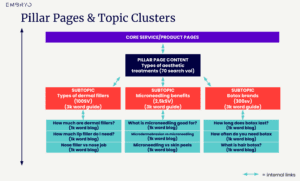
How to produce topic clusters for SEO

Whether you’re a marketer, business, or brand, understanding SEO topic clusters is the key to organising – and creating – great content.
As we’re beholden to search engine algorithms, which have recently changed to prioritise topic-based content, we have to get savvier about how we link related content.
Now one of the main pillars of content marketing, topic clustering lets you organise blogs, resources, and more around core topics – improving your website’s overall visibility.
Whether you’re currently restructuring your site or are looking to get started, this guide will give you everything you need to cluster your content effectively – including real-world examples and common FAQS.
But if you need help getting noticed by readers and the algorithm, talk to our Organic team today.
What is a topic cluster?

In a nutshell, topic clusters are groups of web pages used to establish authority around a particular subject. This aims to get the attention of search engines, who love this approach – and love to reward those building their content hubs around it.
At a glance
Topic clustering is the content approach needed to establish topical authority.
- Pillar page = Your core category/service/topic page
- Cluster pages = Articles that cover associated subtopics
Although clusters will change from topic to topic, you can always expect a main pillar page that provides a broad overview of a subject.
From here, the page will link – and be linked from – multiple cluster pages that touch on related subtopics, creating a huge network of useful information.
A good topic cluster supports category growth across a website while allowing you to cover everything related to a topic – without distracting from your page’s intent.
That means you can still focus on those crucial, high-intent keywords, without sacrificing the good stuff that establishes you as experts.
After all, Google is actively rewarding expert-led content – and with AI Serps and generative search on the horizon, getting topical authority will be more important than ever.
Lucky for you, topic clustering is the best content approach for nabbing those high rankings, while serving your readers useful information.
What’s an example of clustering a topic?
There’s no limit to what you can cluster.
From news sites to industry guides, topic clustering always strives to answer the reader’s questions – or point them in the right direction. For example, BBC News uses related topics and tags to create a comprehensive guide to certain topics – like Brexit or UK-specific news.
But to give you some context, here’s how the SEO experts at Embryo clustered the topic of ‘drills’ for one of our clients – as part of a wider strategy.
Drills
- Drill Buying Guide 2023
- How to choose a drill
- Which drill bits do I need?
- How to drill into brick
- 10 drills you need in your kit
All of these blog pieces are created to support key categories.
- First, we start by auditing existing content pages and grouped them by topic focus.
- If needed, a pillar page noting all the key details of drills is created.
- From here, we can ‘off-shoot’ related topics, creating an evergreen knowledge base that supports that central topic.
Embryo tips to get you started
We tend to tailor the supporting content based on the longer-tail keywords our SEOs come across during our research stage.
Factoring these into your strategy is especially important, as it not only tells Google that your page is useful – but can also support your audience on their purchase journey.
“Long-tail queries account for almost 35% of traffic and almost 50% of all conversions, according to Ahrefs,” says Alisa Thorley, SEO Executive at Embryo.
“Building out a ‘knowledge hub’ or evergreen content to target these queries can majorly improve performance – and get your customers to click and convert!”
So, now that you’ve got the basics, let’s get those clusters started.
How to create topic clusters
To help you, we’ve put together a checklist. These are non-negotiables when it comes to starting, structuring, and sorting your strategies – so make sure you keep these to hand!
Pillar page
Each topic cluster model includes a pillar content piece with internal links to all relevant content in a comprehensive overview.
Extensive research
Even if you’re already an expert in your field, topic clusters need a lot of research. If you want to answer every question – and make the answers easier for your audience to understand – get into their mindset. Existing SERPs, competitor analysis, and online forums are great sources.
Interlinking structure
Your topic cluster needs a really solid internal linking structure. This is based on relevant content, created to improve the user experience and boost organic traffic. Even if your readers can’t find the answer they’re looking for on one page, why not make it easy for them to explore related content?
Engaging content
While working on a topic cluster strategy, make sure that you’re writing better, more engaging pieces of content than those currently at the top of the SERP. This gives you a better chance of knocking them off!
Cluster page do’s and don’ts
These pages should be written like any other blog or guide on your site. But they should also:
- 1. Not mention anything in detail covered on another cluster page or pillar page – you never want to duplicate!
- 2. Content should be in-depth and focus on the long-tail keyword
- 3. It should also link directly to the pillar page early in the blog (so Google is directed to the most important pages!)
What are the benefits of topic clusters?
An effective topic cluster strategy can help with your SEO. Why?
Because the more quality content you publish on a relevant topic, the more keywords you can rank for. From here, you can build more topical authority.
This authority is especially important because Google wants to rank sites that demonstrate Experience, Expertise, Authoritativeness, and Trustworthiness (E-E-A-T).
As well as helping you establish your reputation as an expert, this can also help you attract and engage users – while placing related content into a useful site structure.
Both of these things can boost engagement and search engine rankings, which is bread-and-butter SEO for any business.
So, if you’re serious about what your clients are searching for, then topic clustering comes in clutch.
Get in touch with our experts today to find out more.
FAQs
How many topic clusters should I have?
As a rough average, between 5 to 10 would work for most sites. Just be careful not to overload – or underserve – your cluster, as too much or too little information can prove tricky for search engines to value.
How do I pick my topics?
The first step in building your topic cluster is identifying what you want your blog or brand to be known for. This would serve as your topic cluster’s primary focus – but make sure to pick a more general subject, as it will be broken down into different subtopics later on.
If you’re stuck, think:
- Which topics are important to my brand?
- Which topics have worked well for me previously?
- What is our existing content?
- Which topics does my audience care about?
- What are my competitors doing?


